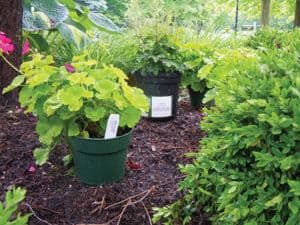By Mary Ellen Shaw
Anything in your garden that you can divide and share provides a connection between you and another person. It will also become a remembrance of you. That may not seem important now but over time you will come to appreciate that someone thought enough of you to share a little piece of their garden with you.

My neighbor Eleanor gave me some of my first perennials about 30 years ago. She mentioned that she has another one that she would like to give me this spring. At my age I should be downsizing my gardens but there’s always room for one more plant! As I look around my gardens I realize that the majority of their contents were provided by neighbors, friends, relatives and coworkers.
It’s not only flowering plants that can be shared but also fruits like raspberry bushes. Mine came from the City of Rutland Delinquent Tax Collector, Vern Richards. We had adjoining offices at City Hall. In the summer he often talked about the large area of his yard that was devoted to raspberry bushes. His wife, Martha, made delicious raspberry jam which was shared with a few lucky coworkers of Vern. He explained to me that raspberry bushes need to be thinned out over time and if I wanted some to stop by and he would tell me which ones to dig up. That was over 30 years ago and I have divided those bushes many times since and given them to numerous people. I always tell them where they originated. For years to come both Vern and I will have a connection to many gardens in the area.
When Eleanor and I were talking recently we reminisced about another neighbor, Ethel, who loved gardening and was quick to share her plants with others. Ethel passed away several years ago and had moved prior to that. But I always remember her when the flowers she shared with me come into bloom.
Eleanor may be the one who was the inspiration for my first perennial garden but Ethel helped to expand my gardens. I would often come home from work to find plants at the foot of my driveway. Perhaps she was like me and had difficulty throwing away plants that needed to be divided. And who would return a plant that was lovingly left for you? I figured that since they were now mine, I had better find a place for them!
Another former neighbor, Marge, contributed plants to a shade garden where I wanted some color. Her pink columbine was a welcome addition to an area that was primarily green. I quickly realized that if I didn’t remove the seed pods I would have more columbine than the garden could handle!
I have done my part in sharing over the years. This summer a couple of people have asked me for a milkweed plant from my garden. Mine is the orange asclepias tuberose variety. Monarch butterflies have been on the decline for many years and milkweed is the only plant upon which they will lay eggs. Some varieties of milkweed are more appealing to monarchs than others. Fortunately, I always see monarchs on this plant. However, the number I see has declined over the years.
It’s best to divide perennials in the spring as their roots will have the whole growing season to recover before winter arrives. It’s a good idea to label the divided plants. After all, everything poking through the ground is green at that time of year making it hard to know what is where! Labels will not only help you but they will also help the people with whom you share your divided plants.
Sharing seeds is another way to connect with a fellow gardener. An empty area can be filled in easily with seeds that germinate quickly. My friend Shirley saves marigold seeds and says that if you scatter them in the garden soil they mature at a rather fast pace. She also grows marigold plants inside during the winter from the seeds she has saved. If you have marigold plants in your garden right now why not try saving the seeds? It sounds like a fun “project”!
So take a look around your garden and see what you can divide and share in the spring. It will soon be time to put our gardens to bed and “recharge” ourselves for another busy season in the garden.




